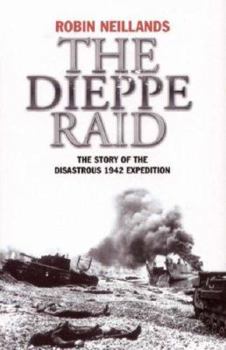The Dieppe Raid: The Story of the Disastrous 1942 Expedition
(Part of the Twentieth-Century Battles Series and Twentieth-Century Battles Series)
Select Format
Select Condition 
Book Overview
The Dieppe Raid is one of World War II's most controversial hours. In 1942, a full two years before D-Day, thousands of men, mostly Canadian troops eager for their first taste of battle, were sent... This description may be from another edition of this product.
Format:Paperback
Language:English
ISBN:1845131665
ISBN13:9781845131661
Release Date:September 2006
Publisher:Aurum Press
Length:292 Pages
Weight:0.54 lbs.
Customer Reviews
3 ratings
A Beach Too Far
Published by Thriftbooks.com User , 15 years ago
There is something intriguing about a military disaster. In America, they continue to rehash Pickett's Charge and Custer's Last Stand. The British ponder what went wrong at The Somme, Gallipoli, and Dunkirk. For Canadians -- its all about the Dieppe catastrophe. In a little over six hours, 4132 out of 6000 men became casualties assaulting a small German occupied French seaport just across the English Channel. By tea- time, the Dieppe Raid became the greatest Canadian catastrophe in World War II -- and all for what? Veteran military author, Robin Neillands reopens the case in his striking new version of Canada's Dieppe Raid of August 19, 1942. Mr. Neillands states "The focus of this book is on why the planners and many of the participants got it so terribly wrong and what factors contributed most directly to the chaos and slaughter on the beaches. It seems a worthwhile project to take Operation Jubilee apart, clear away some of the more common myths and account for the tragic loss of so many men." In the early chapters of Mr. Neillands' narrative, each step of the planning is skillfully dissected and exposed where fault is found: The cancellation of heavy bomber and capital ship support -- the poor radio communications plan -- the lack of clear objectives -- the absence of an overall commander -- an inflexible plan of attack. Unlike the planners of Operation Jubilee, Mr. Neillands, also the author of The Battle for the Rhine The Battle for the Buge and the Ardennes Campaign, 1944, has presented his meticulously researched arguments and findings in a lucid, well thought out manner -- he misses nothing. In seven bloody, smoke-filled chapters, the author tells the waterlogged tale of men struggling in the ocean and along the seawall -- the assault boats of No. 3 Commando blundering into a German convoy -- bullet-ridden landing craft loaded with dead and wounded -- virtually every radio set destroyed right from the beginning -- heroic soldiers charging gun pits with fixed bayonets -- Churchill tanks hopelessly stranded on the promenade -- bodies rolling about in the waves -- hundreds of men cowering behind knocked out tanks and landing craft along the shingle -- eventually, abandoned men on the beach swimming for miles to reach withdrawing ships. Mr. Neillands' remarkable reconstruction of the battle from east to west makes clear the troops had little chance of success. Reaching a verdict, Mr. Neillands finds no fault with the splendid fighting men from Canada and Britain, who eagerly sailed to France -- as should be apparent now, true blame must rest with their fidgety leaders and inept planners. In these pages, men at the top are scrutinized and found lacking. In planning: the entire British Chiefs of Staff Committee; and in the field: Major-General Hamilton 'Ham' Roberts, commander of the 2nd Canadian Division -- all must share responsibility. Though its not much comfort to the families of the 2nd Canadian Division, the Allies
All you wanted to know about Dieppe
Published by Thriftbooks.com User , 16 years ago
I just finished this book - it's written so that the "average" history buff can understand it, but not too "dumbed down" for someone that may use it as a reference for a term paper. It covers everything leading up to this fiasco that cost so many Canadian lives at a crucial time in the war. There were leaders, an then you see the dysfunctional relationship between the sea, air and land elements, even during the landings. My opinion - it should be required reading for military personnel on "how not to plan a military action", and you can understand how military forces of the former British dominions hold their British brothers in questionable esteem.
Good Story of the Raid, Excellent Analysis of the Aftermath
Published by Thriftbooks.com User , 17 years ago
This is an excellent story of the Dieppe Raid conducted in 1942. This raid was, of course, a disaster with the Canadian division losing an incredible number of men. The story of the raid is well told, and the details well told. More important, however, is the authors understanding of the overall implications of the raid. After the disaster all of the military leaders involved rushed to find something to say that could put some saving grace onto the operation. It has become almost understood that this was a precusor to D-Day and that the lessons learned at Dieppe saved thousands on D-Day. The author asks: If this was the plan, why wasn't it mentioned in the before mission planning? Later on, in North Africa Montgomery often expressed a very low opinion of the Americans as a fighting force. This was just after Kasserine Pass. Montgomery conveniently had forgotten that the British took a while to work up to professionalism as well. And one of the steps along the way was Dieppe. This book is worth it for just Mr. Niellands excellent analysis, and worth it even if you know everything about Dieppe.





